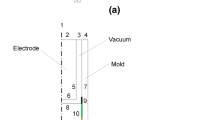Abstract
A crucible-free, an Electrode Induction melting Gas Atomization (EIGA) technique for induction melting of the reactive and refractory metals/alloys is developed. The impedance matching of the superalloy René95 in a conical induction has been investigated. An evaluation of the complex electromagnetic and thermal fields on the free surface of the superalloy René95 is carried out by both numerical and experimental methods under alternating currents with the output power of 120 kW and operational effective current 2 kA. The two types of coupling induction coils have been devised, tested and compared with the experimental results, revealing the impedance of four-turn induction coil with superalloy René95 releasing the electrical energy that causes the most high-temperature distribution in the surface of superalloy René95. Induction coil is also known as an “inductor” which is the core component in the melting process of nickel-based superalloy, leading to design a good induction coil to reduce the power consumption and increase the efficiency of the process. The achievements are the melting rate enhancement and a steady-state of continuous liquid metal flow producing the liquid metal streams with diameter of about 5 mm.












Similar content being viewed by others
References
Franz H, Plochl L, Schimansky F-P (2008) Recent advances of titanium alloy powder production by ceramic-free inert gas atomization. Proc Titanium
Morita A, Fukui H, Tadano H, Hayashi S, Hasegawa J, Niinomi M (2000) Alloying titanium and tantalum by cold crucible levitation melting (CCLM) furnace. Mater Sci Eng A 280(1):208–213. https://doi.org/10.1016/S0921-5093(99)00668-1
Rudnev VI, Loveless D (2014) 12.15 - induction hardening: technology, process design, and computer modeling. In: Hashmi S, Batalha GF, Van Tyne CJ, Yilbas B (eds) Comprehensive materials processing. Elsevier, Oxford, pp 489–580. https://doi.org/10.1016/B978-0-08-096532-1.01217-6
Liu H, Rao J (2009) Coupled modeling of electromagnetic-thermal problem in induction heating process considering material properties. In: Information Engineering and Computer Science. ICIECS 2009. International conference on, 2009. IEEE, pp 1–4
Mühlbauer A (2008) History of induction heating and melting. Vulkan-Verlag, Germany
Atkinson M, Steel U Improving Process Heating System Performance: A Sourcebook for Industry is a development of the BestPractices initiative under the US Department of Energy (DOE) Industrial Technologies Program (ITP) and the Industrial Heating Equipment Association (IHEA). The ITP and IHEA undertook this project as part of a series of Sourcebook publications on industrial utility systems. Other topics in this series include compressed air systems, pumping systems, fan systems, steam systems, and motors and drives
Antony LVM, Reddy RG (2003) Processes for production of high-purity metal powders. JOM 55(3):14–18. https://doi.org/10.1007/s11837-003-0153-4
Gerling R, Schimansky F (2004) Crucible-and ceramic-free melting and atomization of Ti-based alloys. In: Proc. PM 2004 world congress. European Powder Metallurgy Association, UK, pp 77–82
Pleier S, Goy W, Schaub B, Hohmann M, Mede M, Schumann R (2004) EIGA–an innovative production method for metal powder from reactive and refractory alloys. PM2TEC, MPIF, Princeton
Wang XF, Zhou XM, Yang J, Zou JW, Wang WX (2013) Detection and deformation mechanism of non-metallic inclusions in FGH96 alloy isothermal forging disk. In: Materials Science Forum. Trans Tech Publ, pp 526–534
Ma W-b, G-q L, Hu B-f, Y-w Z, J-t L (2013) Effect of Hf on carbides of FGH4096 superalloy produced by hot isostatic pressing. Mater Sci Eng A 587:313–319
Shan F, Min X, Chang-Chun G (2017) Consecutive induction melting of nickel-based superalloy in electrode induction gas atomization. Chinese Physics B 26(6):060201
Dughiero F, Baake E, Forzan M, Bojarevics V, Roy A, Pericleous K (2011) Numerical model of electrode induction melting for gas atomization. COMPEL-The International Journal for Computation and Mathematics in Electrical and Electronic Engineering 30(5):1455–1466
Han Y, Yu E-L, Zhao T-X (2016) Three-dimensional analysis of medium-frequency induction heating of steel pipes subject to motion factor. Int J Heat Mass Transf 101:452–460. https://doi.org/10.1016/j.ijheatmasstransfer.2016.05.017
Kranjc M, Zupanic A, Miklavcic D, Jarm T (2010) Numerical analysis and thermographic investigation of induction heating. Int J Heat Mass Transf 53(17):3585–3591
Lu L, Zhang S, Xu J, He H, Zhao X (2017) Numerical study of titanium melting by high frequency inductive heating. International journal of heat and mass transfer 108 (part B):2021-2028. https://doi.org/10.1016/j.ijheatmasstransfer.2017.01.062
Wai HP, Soe S, Aung A, Win T (2008) Work coil design used in induction hardening machine
Fu X, Wang B, Tang X, Ji H, Zhu X (2017) Study on induction heating of workpiece before gear rolling process with different coil structures. Appl Therm Eng 114:1–9. https://doi.org/10.1016/j.applthermaleng.2016.11.192
Shi C, Zhong Z, Feng D (2012) China Superalloys handbook. China Zhijian Publishing House and Standard Press of China, Beijing, p 612
Author information
Authors and Affiliations
Corresponding authors
Ethics declarations
Conflict of interest
The authors declared that they have no conflicts of interest to this work.
Additional information
Publisher’s Note
Springer Nature remains neutral with regard to jurisdictional claims in published maps and institutional affiliations.
Rights and permissions
About this article
Cite this article
Shan, F., Xia, M. & Ge, CC. An EIGA driven coupled of electromagnetic-thermal field modeling in the induction melting process. Int J Mater Form 12, 615–622 (2019). https://doi.org/10.1007/s12289-018-1438-z
Received:
Accepted:
Published:
Issue Date:
DOI: https://doi.org/10.1007/s12289-018-1438-z




